The Islamic impact in the Philippines goes far beyond Mindanao and Manila, even before the 1500s. This part of Philippine history shows how Islamic teachings spread across the islands. It also highlights their big influence on the Philippines’ culture and beliefs.
Before being colonized, Islam in the Philippines was very influential. It shaped not just religious beliefs but also war tactics and how communities governed themselves. Muslim groups in the Dunia Melayu, or Malay World, built their social, economic, and cultural structures.
This article will explore the history of Islamic influence in the Philippines. It will look at the early spread of Islamic teachings, the changes in religious leaders called Panditas, and Islam’s role in war. We’ll also see how encounters with Spanish Jesuits and Moro resistance affected these dynamics. Plus, we’ll learn about the role of traditional Madrasah education and examine misunderstood parts of the history from Jesuit writings.
Key Takeaways:
- The Islamic influence in the Philippines extends beyond Mindanao and Manila, even before the 1500s.
- Islam played a significant role in shaping religious beliefs, warfare, and governance during the pre-colonial period.
- Muslim communities in the Dunia Melayu crystallized, developing their own social, economic, and cultural systems.
- Encounters with Spanish Jesuits and Moro resistance shaped the interaction between Islamic and colonial forces.
- Panditas, influential figures, transformed and adapted as Islam rose in prominence.
Keep reading to find out more about how Islamic influence shaped the Philippines’ history and culture.
Source: US Institute of Peace
The Dawn of Islamization in the Philippines
Islamic teachings reached the Philippine archipelago in the early Christian centuries. This marked the start of Islamization in the region. We’ll look at how Islamic teachings first arrived and changed local cultures. This gives us a historical view of Islam’s spread in the Philippines.
Arrival of Islamic Teachings and Their Foundational Impacts
When Islamic teachings came, they transformed the area’s religious, cultural, and social landscapes. Scholars and merchants from the Muslim world were key in spreading Islam to the locals.
These teachings influenced everything from religion to art in the Philippines. They highlighted justice, compassion, and social welfare. This led many to embrace Islamic values.
“Islamization in the Philippines brought about a profound transformation. Islam not only influenced religious practices but also built a fairer society.”
Islam’s growing influence created Muslim communities across the islands. These places thrived in learning, trade, and governance. They helped the area’s cultural and economic growth.
Spread of Islam in the Archipelago: A Historical Perspective
The spread of Islam took centuries, influenced by many factors. Exploring the history shows us how the religion grew all over the islands.
Trade with Muslim parts of the world was vital in spreading Islam. This was boosted by the Philippines’ position in sea routes. It quickly spread Islamic teachings.
Figures like Sharif Kabungsuwan and Makhdum Karim were important in Mindanao and Sulu. They, along with local leaders turning to Islam, helped the religion spread widely in these areas.
The historical lens also looks at how the Philippines interacted with its neighbors. It talks about cultural trade and the conflicts that influenced Islam’s spread.
This study aims to show how Islam’s first days in the Philippines are important. It looks at the religion’s effect on the people’s culture and faith.
| Key Events | Key Figures | Factors |
|---|---|---|
| Introduction of Islamic teachings through trade | Sharif Kabungsuwan | Strategic location in maritime trade routes |
| Establishment of Muslim communities | Makhdum Karim | Influence of local rulers |
| Socio-political context and interactions with neighboring kingdoms | Cultural exchanges and conflicts |
The Role and Function of Panditas in Pre-Colonial Philippines
In the time before the Spanish arrived, Panditas were key figures in the Philippines. They were experts in Islamic teachings and spirituality. They shared their knowledge with the local communities. People respected them for their deep understanding of religious and moral issues.
Panditas not only taught Islamic wisdom but also mixed it with local customs. This union formed a special culture that showed the area’s diverse heritage. This blending process was important for unity and peace.
Panditas helped make Islamic principles a part of everyday life. They guided people spiritually and settled disagreements. Besides their religious roles, they were also important in legal and political matters.
Filipino shamans, like babaylan, were also vital in the pre-colonial era. Though different from Panditas, their spiritual and healing roles paralleled each other. Interaction between these two groups mixed local spiritual beliefs with the Islamic teachings. This addition enriched the Philippines’ spiritual and cultural background.
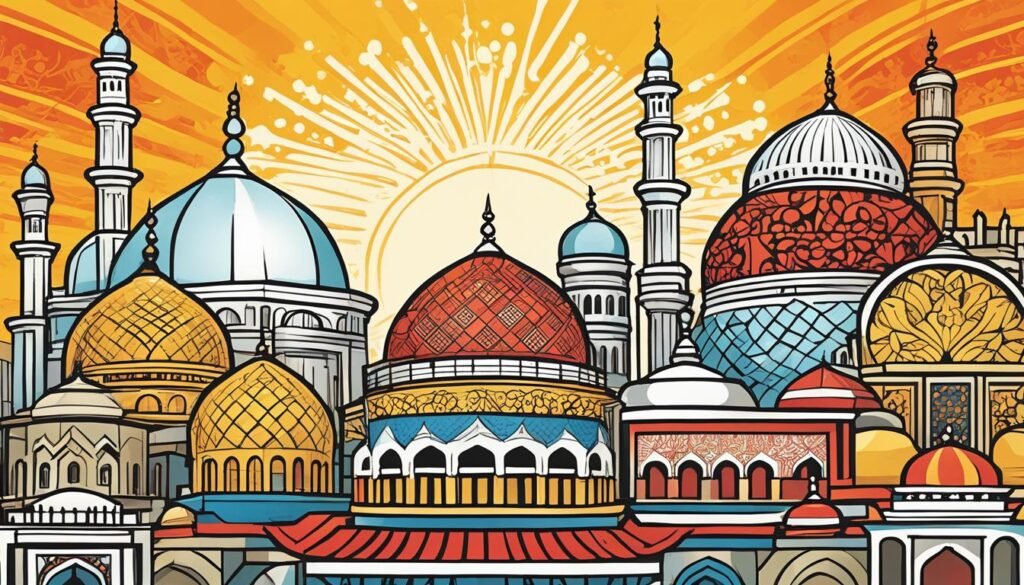
| Role and Function of Panditas | Examples |
|---|---|
| Promoting Islamic teachings | Transmitting religious knowledge to the community through oral teachings and written works |
| Spiritual guidance | Assisting individuals in matters of faith, morality, and personal growth |
| Resolving disputes | Acting as mediators in conflicts and providing arbitration based on Islamic principles |
| Political participation | Advising local leaders and contributing to governance structures within the community |
| Promoting cultural synthesis | Facilitating the integration of Islamic principles with indigenous traditions and practices |
Crystallization of Muslim Communities in the Dunia Melayu
In the pre-colonial time, Muslim groups in the Dunia Melayu worked hard to strengthen their social and cultural ties. They built their own ways of governing and focused on saving their Muslim identity.
Leadership and systems for making decisions were key during this time of change. Different areas had their own unique ways of organizing. For example, in Sulu and Maguindanao, there were sultanates. But in other places, leaders were called datu.
Building strong social connections within these communities was also very important. These connections helped people work together and feel like they belonged. They were based on the idea of treating others with kindness, fairness, and helping each other out. This created a peaceful and welcoming community.
Doing business and trading was crucial too. Muslim communities in the Dunia Melayu were very active in trade, farming, and making things by hand. They established bustling marketplaces and became known for their goods. This success not only made them rich but also helped in sharing ideas and cultures.
This image captures the growth and connections between Muslim communities in the Dunia Melayu back then.
As the Muslim communities in the Dunia Melayu grew, they formed strong social, cultural, and political systems. Their way of governing, their social rules, and economic work helped keep their Islamic identity strong.
To learn more about this topic, check out this resource.
Encounters with Spanish Jesuits and Their Consequences
This section delves into the interactions between the Spanish Jesuits and the local Muslim groups during the Philippine colonial period. These encounters profoundly affected both sides. They influenced the religious, social, and political aspects of that time.
Religious Frictions and the Struggle for Mindanao
The Spanish Jesuits’ arrival in Mindanao and other Muslim areas sparked religious tension. The local Muslim communities were used to Islam and were against the Spanish’s effort to change their faith. The fight for Mindanao also became part of Spain’s wider plan in the Philippines.
“The clash of religious beliefs and practices between the indigenous Muslims and the Spanish Jesuits created tensions and fueled conflicts in Mindanao. The indigenous communities fiercely defended their Islamic faith and way of life, with the Spanish encountering resistance at every turn.”
To gain control and convert Muslims, the Spanish Jesuits had many plans. They carried out Christian missions, built churches, and tried to make the Muslim communities follow their doctrine. This action caused even more religious friction and increased the struggle for Mindanao’s control.
Assessing Spanish Colonial Strategies and Jesuit Missions
Examining Spanish colonial methods and Jesuit missions needs an understanding of that time’s context. The Spanish wanted power over the islands. They believed converting Muslims to Christianity was key to this.
The Jesuits played a big part in these efforts, using a mix of teaching, diplomacy, and sometimes force. They wanted to swap the local religious practices with Christianity. But, they often faced resistance, leading to ongoing tension.
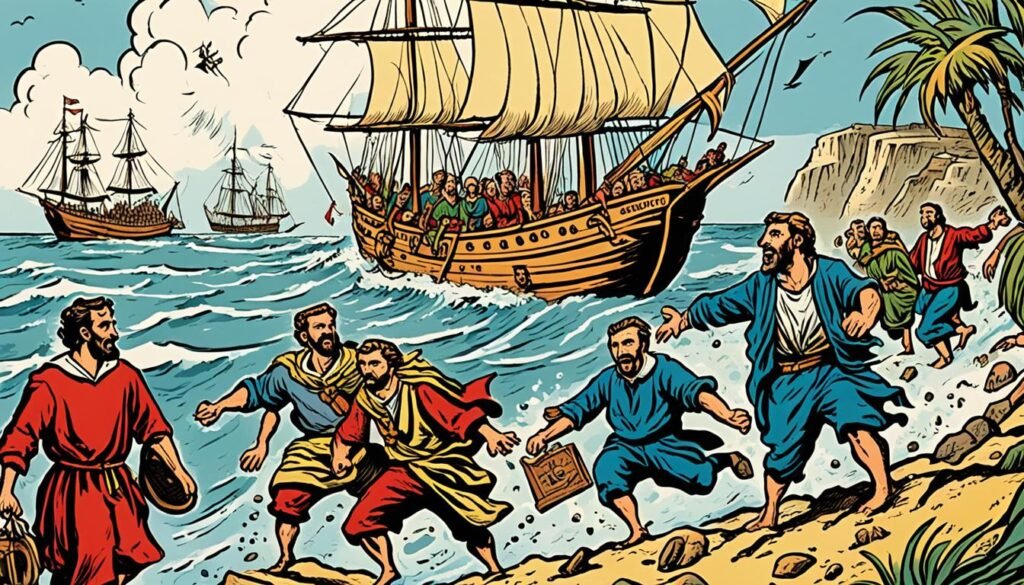
The Spanish Jesuits’ dealings with the Muslim communities in the Philippines were complex. They involved power struggles, cultural differences, and the clash of religious views. These interactions heavily influenced Mindanao’s history. And they left a deep mark on the area’s religious and social setup for many years.
| Impact of Encounters with Spanish Jesuits | Consequences for Indigenous Muslim Communities |
|---|---|
| Conversion attempts and Christianization | Resistance to the imposition of Christianity |
| Erosion of indigenous religious practices | Persistence and adaptation of Islamic beliefs and traditions |
| Displacement and marginalization | Struggle for autonomy and self-determination |
| Influence on sociopolitical dynamics | Formation of distinct Muslim identities and communities |
The Transformation of Panditas with Rising Islamic Consciousness
In the Philippines, Panditas went through a big change. They were important in the pre-colonial times, keeping cultural and spiritual knowledge. After Islam came, Panditas started to look and act more like Islamic leaders.
From Pre-Islamic to Islamic Identifiers in the Evolution of Panditas
Panditas were known for their wisdom before Islam arrived. Their teachings came from local beliefs. When Islam became more popular, Panditas began to follow its ways. This included Islamic prayers and wearing clothes that showed their Islamic faith.
With these changes, Panditas showed the shift in the Philippines’ religious scene. They became key in spreading Islamic ideas and leading Muslim groups.
Understanding Panditas within New Religious Narratives
Understanding Panditas needed looking at new religious stories. These new tales helped explain Panditas’ roles in the changing religious scene. They also showed how significant they were in the new Islamic context.
The image above shows how Islamic faith grew and changed Panditas in the Philippines. This change marked the strong connection of Panditas with the growing Muslim community.
Looking at how Panditas changed gives us insight into the Philippines’ past. It shows us the mix of old and new religious beliefs.
By exploring Panditas’ journey, we see the complex mix of traditions in Filipino Islam. It shows a unique Filipino Islamic identity forming.
Military, Diplomacy, and the Islamic Influence in Pre-1500s
In the time before the 1500s, Islam’s reach in the Philippines went far beyond faith and culture. It deeply affected both military and diplomatic matters. Islam was key in protecting Muslim territories and spreading their power. The Muslim communities used smart strategies, forming alliances and tactics to protect their lands effectively.
Defense against External Threats: Islamic communities in the Philippines had to deal with many outside threats. They worked hard to keep their lands safe. Muslim leaders built strong defenses, placed their troops wisely, and used smart military plans to keep invaders out. Their main goal was to protect their people, their beliefs, and their way of life.
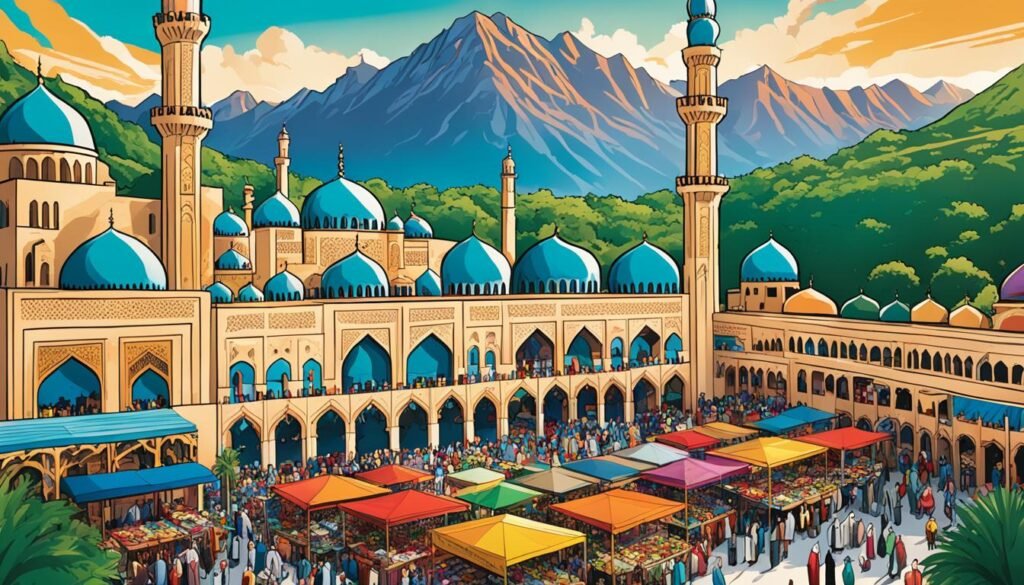
Expansion of Muslim Territories: Islam was also crucial for growing Muslim lands in the pre-1500s Philippines. Muslim groups went on diplomatic missions. They made important alliances with nearby kingdoms and tribes. These alliances helped open up new opportunities for trade and influence.
Islam’s warfare wasn’t just about battles. It also involved using diplomacy for peace. Muslim leaders talked, made treaties, and helped settle disputes, to build strong relationships with others.
The ongoing Islamic influence protected the Muslim community’s customs and beliefs. It also helped them stand out in the pre-1500s Philippines’ varied political scene. Due to their efforts in military and diplomacy, they kept their unique identity.
If you want to know more about Islam’s roles in pre-1500s Philippines, check out this document.
Perspectives on Moro Resistance: Identity and Insurgency
To grasp the Moro (Muslim) resistance in the Philippines, one must consider different viewpoints. These help us understand their fight for identity and independence. The Moro’s resistance story is rich with culture and history, showing their quest for self-rule and recognition.
The Moro people’s fight for their land and ways is deeply tied to their cultural roots and faith. This fierce grip on their identity has served as a shield against outside efforts to change or minimize them.
Resistance among the Moros has varied, from peaceful stands to taking up arms. They face social, political, and economic hurdles in their fight, such as discrimination and loss of land. These challenges push them harder to fight for their rights and shape their future.
Moro’s insurgency shows both organized and scattered actions, aiming for self-rule and the preservation of their cultural and religious identity. They fight for a place in the Philippine system that values their unique background and long history in the area.
The path to addressing Moro resistance is tangled with social and political issues. Efforts for peace aim to heal the Moro-central government rift, emphasizing fair leadership and settling old grudges.
In moving towards a more inclusive Philippine society, understanding Moro resistance is key. It calls for respect of their identity and struggle, aiming for a more united and fair society.
Reconstructing Sociopolitical Landscapes Through Literature
Before the 1500s, the Philippines’ sociopolitical scenes were unique. We learn a lot by looking at old writings and history. These sources tell us a lot about how Islam shaped the area.
Stories and views from various groups teach us about life back then. Spanish writings give us a look from their side, talking about encounters with locals. This includes the Muslims living in the Philippines.
But, the locals’ own stories offer a different view. They tell tales and share texts, showing their unique culture. This adds depth to our understanding of Islamic influences on them.
Islamic writings and items are also key. Things like Qur’anic texts share the beliefs of early Muslims there. They give us hints on their daily life and thoughts.
Objects like pottery and jewelry connect us to that time. They show links to Islamic customs and trade. This tells us more about their society and practices.
All these pieces help us see the past. By using literature, artifacts, and more, we paint a better picture of early Philippine life. The mix of these items shows the strong and lasting impact of Islam on the country.
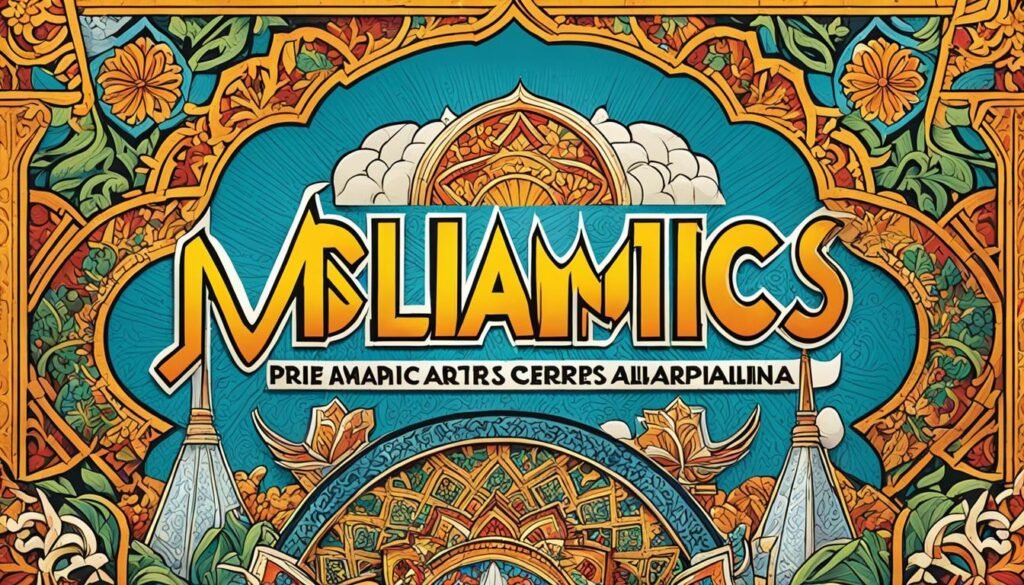
Jesuit Chronicles: Distortion and Defense of Islamic Influence
This part looks at how Jesuit writings shaped the story of Islamic impact in the Philippines before the 1500s. Mainly written by Spanish Jesuit missionaries, these writings show what happened when the local Muslim groups met the Spanish. But, we should see these accounts with a critical eye for possible distortions and biases.
The Jesuit writings point out the religious tensions and clashes that occurred as the Spanish took over Mindanao and other Muslim areas. These stories, tinted by religious prejudice and colonial goals, might not show the full picture of Islamic life in the islands. They mainly talk about the dangers and opposition the Spaniards faced, highlighting how hard it was to change the locals’ beliefs.
There are other views that aim to correct these one-sided stories of the Jesuits and champion the real Islamic influence in the Philippines. These views talk about peaceful life, sharing of cultures, and the strong Muslim communities that were there before the Spanish. They stress the role of Islam in shaping how society, politics, and religion were before the colonizers came.
Approach the Jesuit writings with care, understanding they may not be completely balanced. Looking at other perspectives helps us see the real impact of Islam in the Philippines before the 1500s.
Pre-Colonial Educational Frameworks in Muslim Philippines
The Import of Traditional Madrasah Education
The Philippine pre-colonial periods were full of educational traditions. The traditional Madrasah was very important. It taught knowledge and religious beliefs. This helped shape the Muslim Philippine culture.
The Madrasah system came from the Arab world through trade and cultural connections. For centuries, it was a key part of education in Muslim Filipino areas. These centers of learning, called Madrasahs, taught students about Islamic faith, law, and morals. They also learned Arabic and other subjects.

The Madrasahs brought deep understanding of Islamic beliefs. They focused on the Quran, Hadith, Fiqh, and other teachings. This rich curriculum was meant to pass Islamic knowledge on to new generations.
Religious education in the Madrasahs was the base of the Muslim community’s faith and heritage. These schools didn’t just produce religious scholars. They also shaped leaders like imams, judges, and teachers. The Muslim Philippines’ education system was firmly built on Islamic teachings.
Today, the Madrasahs in the Philippines keep teaching about the Islamic faith. They are important in keeping the religious and cultural identity of Muslim Filipinos strong. They also help in the general education of the community.
To learn more about the educational frameworks within Islam, consider exploring Education in Islam on Wikipedia.
Islam’s Influence on Healthcare and Medicine
Islam shaped many parts of Philippine life, including health and medicine. Early Philippine healthcare combined Islamic faith with medical knowledge. This mix created a health system that stood out.
Islamic teachings, found in the Quran and Hadith, are at the core of healthcare in Islam. They focus on keeping the body, mind, and soul healthy. This leads to a complete approach to well-being.
Islamic Healthcare Practices
Islam’s health methods integrated into early Philippine care included various therapies and cures. These were part of Islamic teachings. Some practices are:
- Tibb-e-Nabawi: Known as Prophetic medicine. It uses natural remedies and diet advice from the Prophet Muhammad (pbuh) for good health.
- Hijama: Cupping therapy helps clean the blood and increase circulation. It involves placing suction cups on the skin.
- Ruqyah: Healing through Quranic verses. It’s believed to heal the spirit and mind, treating many illnesses.
Integration of Islamic Principles
Islam’s teachings went beyond actual health practices. They also stressed caring for others. This led to hospitals and clinics that helped everyone, no matter their wealth.
Islam’s focus on cleanliness benefited the health system too. It added practices like washing hands to stop diseases from spreading. These teachings shaped not just personal habits but also medical methods.
Islamic medical knowledge came to the Philippines through trade and cultural sharing. This helped the country’s healthcare advance.
Traditional Healing and Islamic Influence
Early Filipino healing mixed Islamic and local traditions. It involved using plants, prayers, and ceremonies. This mix made people trust these treatments more.
Mixing Islamic faith with local healing made treatments more effective, in people’s eyes. It created a healthcare system that met both physical and spiritual needs.
The impact of Islam on early Philippine healthcare shows its broad teachings. This mix of faith and science produced a healthcare approach that cared for the whole person.
Visions of Islamic Utopia: From Sulu Sultanate to Cultural Imaginings
This part looks at the dream of an Islamic paradise and how governing ideals played out in the Philippines. This was especially true for the Sulu Sultanate and other Islamic places of power.
Examining the Ideals and Governance in Islamic Political Entities
The Sulu Sultanate stood out for its vibrant history and regional power. It dreamed of a perfect Islamic society. This vision included living by Islamic values, bringing peace, fairness, and wealth to everyone.
Important themes in Islamic politics were fairness, talking things out, and being held responsible. They aimed for a society where everyone had a say, making sure all felt included in the decision-making.
The dream of an Islamic paradise included helping those in need, educating everyone, and economic growth. Leaders in the Sulu Sultanate worked hard to build systems that uplifted the entire community.
This dream of a perfect Islamic society influenced life and politics back then. Plus, it added to discussions on how to lead fairly in Islamic cultures.
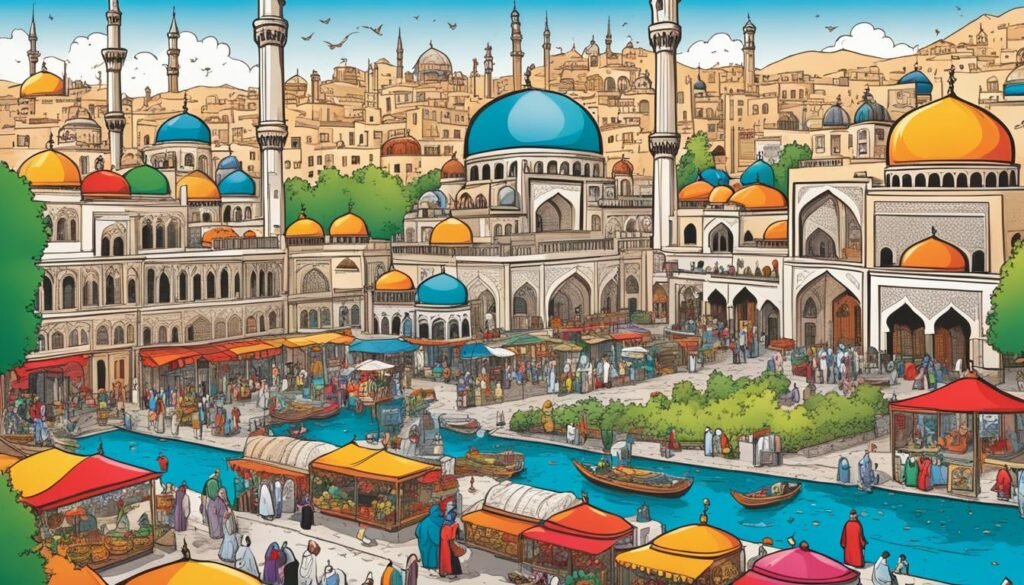
The ideas and dreams from Islamic politics are still inspiring talks on governing today. They’re looked at in terms of modern Islamic thinking and application in today’s world.
Exploring these old Islamic governing ideas helps us understand their effect. They changed societies in the Philippines and beyond.
Learn more about the impact of Islamic ideals and governance in the Philippines during this transformative period.
Conclusion
The exploration into Islamic influence outside Mindanao and Manila pre-1500s is eye-opening. It sheds light on Filipino history, culture, and identity. This Islamic spread heavily impacted the sociopolitical life back then.
Looking back at the early spread of Islam highlights its acceptance into local life. Through this, Muslim communities emerged in the Dunia Melayu region. It showed how deeply Islam became a part of pre-colonial Philippine society.
When the Spanish met the Islamic Philippines, tensions arose. This led to clashes between Islamic and Christian beliefs. However, the Moro people’s resilience against colonization shows their strong identity.
Researchers have used literature to dive into the past’s Islamic influence. They analyzed old documents to understand this period. The insights gained reveal the true impact of Islam in early Philippines.
The Islamic culture of the pre-1500s Filipino lifestyle stays with the nation today. Recognizing its importance helps us value Filipino history and culture more.
Learn more about the topic from Brookings Institution.


